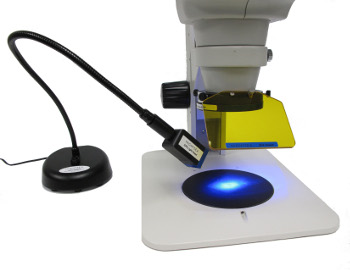Oct 3 2013
Fluorescence microscopy, the “tool of choice” for research biology and live cell work, is rapidly expanding from conventional compound microscopes to stereo microscopy. Until recently, however, its cost and complexity have limited that expansion to high-end, research level stereos.
The novel and easy-to-use Stereo Microscope Fluorescence Adapter (SFA) from NIGHTSEA™ (Bedford, MA) dramatically lowers that barrier. Fluorescence is now available as an inexpensive add-on to existing microscopes, bringing new life to the installed base of hundreds of thousands of smaller, laboratory level stereos.
 Stereo Microscope Fluorescence Adapter from NIGHTSEA
Stereo Microscope Fluorescence Adapter from NIGHTSEA
A visit to NIGHTSEA.com is a visual treat. The SFA has now been installed in labs around the world for stereo imaging, simple sorting, and fluorescence-assisted dissection. Educators in secondary education, colleges, and universities now find it easy to add the intriguing hidden world of stereo fluorescence to their curricula. Reflecting this rapid proliferation, the NIGHTSEA website contains brilliant stereo fluorescent images of a wide range of plant and animal models, from coral, Arabidopsis and C. elegans to Drosophila, Xenopus, and zebrafish.
"I started out making equipment for myself to explore for fluorescence in the sea while SCUBA diving at night,” explained inventor and NIGHTSEA President, Dr. Charles Mazel. “The challenge of working underwater in the dark is a great motivator for making simple, reliable gear that just plain gets the job done. This mindset translates into everything NIGHTSEA makes for laboratory and field equipment." He will be demonstrating the system in the Electron Microscopy Sciences booths at the upcoming Society for Neuroscience meeting (Exhibit dates: November 10-13, San Diego Convention Center, Booth #3000/3004 ) and the American Society for Cell Biology (Exhibit dates: December 15-17, New Orleans Convention Center, Booth #703).
The SFA system is a fully modular system, offering four interchangeable excitation/emission combinations designed to meet a wide range of fluorescence requirements. Users can purchase just the modules which that fit their immediate needs then expand at any time. Excitation wavelengths include violet, royal blue, cyan, and green. A white light head is now also available.
As illustrated in a 3-minute video available on the website, changing from one wavelength to another involves three quick steps: Exchange the LED head on the free standing goose-neck,
snap the magnetically-attached barrier filter onto the universal adapter below the front lens of the microscope, and swap the filter shield using a one-screw attachment.
For further details on the SFA, visit NIGHTSEA.com or their distributor, Electron Microscopy Sciences.